Quinoa - the superfood in the 21st century
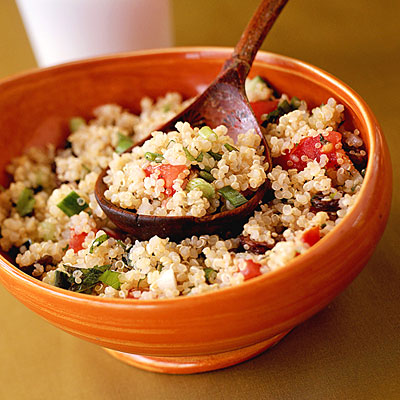
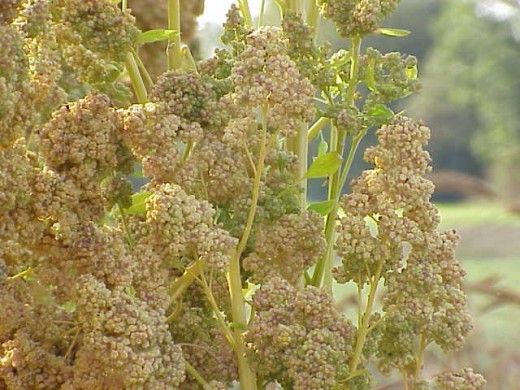
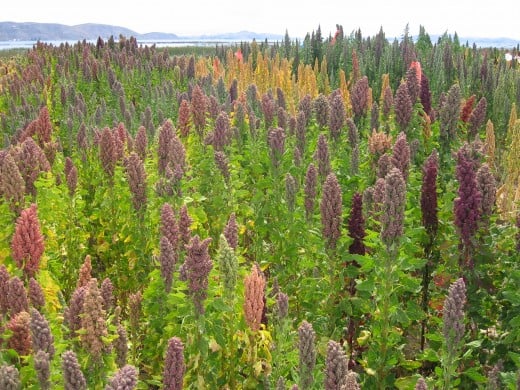
The 'new' superfood of the 21st century, quinoa (pronounced keen-wa) has recently been rediscovered as a nutrient rich, gluten free seed, not a grain, that can be cooked the same way as rice and can be used in a wide range and variety of dishes.
Quinoa is a seed which is prepared and eaten similarily to a grain. Quinoa is a non-GMO, glueten free and is usually grown organically.
I only recently discovered quinoa myself, although it has been around and popular for several years. I enjoy the nutty taste of this seed and I have substituted quinoa for the use of rice in several meals and dishes.
It originally was found grown in the Andean Mountains of South America, specifically in the countries of Peru, Bolivia, Ecuador and Colombia. It has been around since approximately 3000 BC and was an everyday staple of the Inca people's diet who resided in the west coast of South America in the 15th and 16th centuries. Today, it is still grown high in the Andes Mountains in the cool, thin air and dry soil. The majority of the quinoa sold and eaten today is still cultivated and harvested in the Andes Mountains.
The name quinoa comes from the Quecha language of the Incas and is a species of goosefoot. Chenopodium, a grain crop grown primarily for its edible seeds. It is not a member of the true grass family and is considered a pseudocereal rather than a true cereal. It is closely related to the families of beetroots, spinach and tumbleweeds.
Its nutritional value cannot be surpassed as it is high in protein, gluten-free and its nutrient make-up is favorable compared with common cereals. Quinoa seeds contain essential amino acids like lysine and quantities of calcium phosphorus and iron. The entire plant is edible as the leaves can be eaten as a leafy vegetable and the stalks can be eaten also.
After harvest, the seeds must be processed to removed the coating containing the bitter tasting saponins. The seeds are then cooked the same way as rice and, therefore, can be used in a wide range of dishes. It has been an important staple in Andean cultures and has today now become a staple in diets internationally
Quinoa has a nutty, rice taste and is now used in a variety of dishes such as cereals, salads, main dishes and desserts. There is no end to how quinoa can be used in recipes.
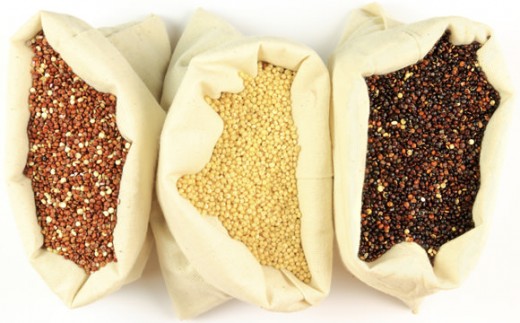
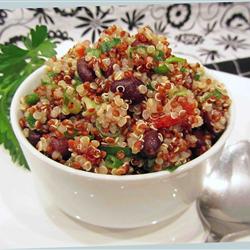
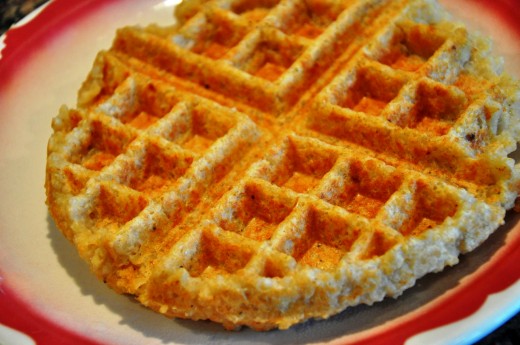
Related link
- Four Healthy Herbs and a Spice to add to your meals
Add these healthy herbs or spice to your meals and not only enhance the taste but boost your health as well.
Quinoa History
The quinoa plant is indigenous to the Andes Mountains region of South America but has been prettyh much obscure in the rest of the world. It became an important staple in the Andean cultures, specifically of the Inca people. The Incas believed the quinoa crop to be sacred and they referred to it as the "mother of all grains," even though it is a seed.
Maize (corn) and quinoa became the two mainstay foods of the Inca empire which began around 1200 AD. It was a food that could survive in a wide variety of growing conditions.
Chenopodium quinoa is believed to have been domesticated in the Peruvian Andes from the wild or weed plants of the same species.
Traditionally, the Inca emperor would sow the first steeds of the season as it had status within the indigenous ceremonies of the Incas and those living in the Andes. However, when the Spanish conquered the Incas, they scorned quinoa as "food for indians," and not worthy for the Spanish colonists to eat.
The Spanish suppressed quinoa's cultivation and even forbade its cultivation and forced the Incas to grow wheat instead.
As time moved on the seed has become popular in the U.S., Canada, Europe, Australia, China and Japan. Because it has become popular today, the crop value has increased substantially.
It is compatible with the soil and climate of the Andean region and was used over the years mostly as a peasant food that provided farming families with important nutrients.
Today, quinoa has become an everyday food of urban Bolivia's middle class and is a luxury food in the Peruvian capital city of Lima.
In 2013, the United Nations General Assembly named the year as the International Year of Quinoa because of its increased popularity, cultivation and health benefits and in recognition of ancestral practices of the Andean people.
The United Nation's objective was to draw attention to its nutritional properties for present and future generations and especially how to live in harmony with nature.
Today, most of the quinoa consumed in the U.S. comes from South America, specifically Peru, the largest commercial producer of quinoa and Bolivia, the second larges producer of it. These two countries produced nearly 99% of the commercially grown quinoa in 2010. And, recently the U.S. has begun cultivating quinoa in the Colorado Rockies as the climate and soil are similar to that in the Andes Mountains.
The quinoa seed today is grown in coastal areas at more than 4,000 m (13,000 ft) in the Andes near the equator. The best growing conditions are in cool climates with temperatures that vary between 25 degrees F (-4 degrees C) during the night and near 95 degrees F (35 degrees C) during the day. Light frosts do not affect the plant at any stage of development.
Growth is best with well-distributed rainfall during early growth of the seed and development of dry conditions during the seed's maturation and harvesting. Since 1982, the U.S.has grown quinoa primarily in the high elevation of the the Colorado Rockies.
The growing season in the U.S. is short in cultivating guinoa and is most like the maturity varieties typical of the Bolivian origin. Quinoa plants do best in sandy, well-drained soils with low nutrient content, moderate salinity and has a soil pH of 6 to 8.5.
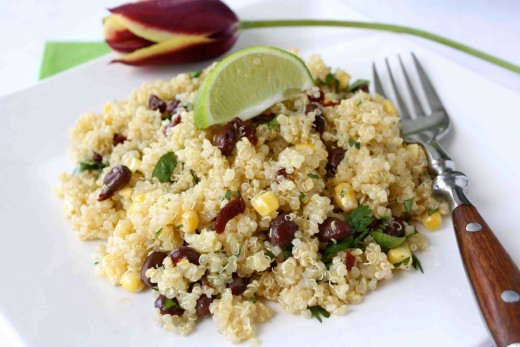
Nutritional value of quinoa
The quinoa seed has been called a superfood in the 21st century because of its nutrients. The protein content of quinoa per 100 calories is higher than brown rice, potatoes, barley and millet. The seed is a good source of dietary fiber and phosphorus and is high in magnesium and iron and is also a good source of calcium.
Quinoa is high in fiber, usually 10-16 grams of fiber per 100 grams. This helps to reduce blood sugar levels, cholesterol levels and weigh loss.
It is also a good food for vegans and for anyone who suffers from lactose intolerance. It is gluten free and easy to digest. Quinoa is non-GMO and is usually grown organically. Quinoa includes molecules called flavonoids (plant anti-oxidents). Its two flavonoids are quercetin and kaempferal which contain anti-inflammatory, anti-viral, anti-cancer and anti-depression effects.
Quinoa is also high in protein compared to most plant foods and contains all the essential amino acids that we need in our diet.

Benefits of quinoa
There are many benefits to adding quinoa to our diets. Its anti-oxident properties are greater than those in cranberries, blueberries or ligonberries. When eaten on a daily basis, quinoa helps to decrease the risk of inflammation-related problems and diseases. The anti-inflammatory nutrients help to protect human blood vessels from inflammatory damage.
It also provides valuable amounts of heart-healthy fats like monosaturated fat. It also provides small amounts of the omega-3 fatty acid alpha-linolenic acid. And, the most important health benefit of quinoa is its overall nutrient richness.
Another benefit is to type 2 diabetes as it has a strong intake of protein and fiber which are two dietary essentials for regulation of blood sugar. The anti-inflammatory nutrients found in quinoa also makes it a great benefit for diabetes risk reduction.
Adding quinoa to our diet will lower total cholesterol and helps maintain levels of HDL, the good cholesterol.
The anti-oxident and anti-inflammatory phytonutrients also make it an anti-cancer benefit. It is excellent for the digestive track as it aids in digesting food and, therefore, is also an anti-colon cancer property.
It also benefits in reducing allergies and adverse reactions caused by certain other grains. It is a good substitute for wheat and because it is gluten free, it is a great substitute for any gluten-containing grain.
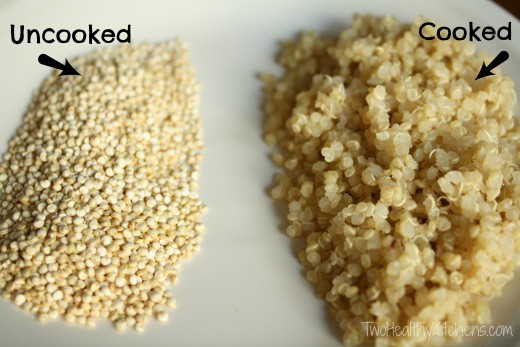
Cooking quinoa
Cooking quinoa is easy and takes about fifteen to twenty minutes to make:
- Put 2 cups of water in a saucepan or pot
- Add 1 cup of raw quinoa and add a dash of salt and cover
- Boil for 15-20 minutes or until all water is absorbed
- Remove from heat and let stand of 5 minutes covered
- Fluff with a fork and eat.
Cooked quinoa seeds are fluffy and creamy and also slightly crunchy and have an amazing translucent appearance. The seeds' flavor is delicate and somewhat nutty.
Quinoa can be bought pre-packaged as well in bulk from bins. If bought in bulk, quinoa should be stored in an airtight container and it will keep three to six months if stored in the fridge. To cook, always add one part quinoa to two parts liquid.
Fruit and nuts can be added to cooked quinoa and served as a breakfast porridge. Homemade noodles can be made from ground quinoa. Sprouted quinoa can be used in salads and sandwhiches similar to alfalfa sprouts.
Quinoa can be added to our favorite vegetable soups. Ground quinoa flour can be added to cookie and muffin recipes. And, it is great to use in tabboulah, a Middle Eastern dish.
Below are two recipes using quinoa as its base.
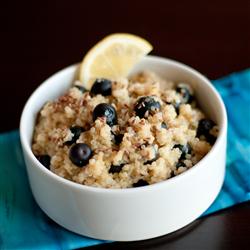
Blueberry Lemon Breakfast Quinoa
Ingredients:
1 cup quinoa
2 cup nonfat milk
1 pinch of salt
3 tsp. maple syrup
1/2 lemon zested
1 cup blueberries
2 tsp. flax seed
Directions:
- Rinse quinoa in a fine strainer with cold water to removed bitterness until water runs clear and is no longer frothy.
- Heat milk in a saucepan over medium heat until warm, about 2-3 minutes. Stir quinoa and salt into milk; simmer over medium-low heat until much of the liquid has been absorbed, about 20 minutes. Remove saucepan from heat. Stir in maple syrup and lemon zest into the quinoa mixture. Gently fold blueberries into the mixture.
- Divide quinoa mixture between two bowls; top each with 1 tsp. flax seed to serve
Prep - 5 minutes Cook - 25 minutes Ready - in 30 minutes
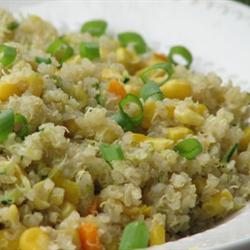
Quinoa with Veggies
Ingredients:
1 cup quinoa
3 cups water
1 pinch salt
3 tbsp. olive oil
3 cloves garlic, minced
1 red bell pepper, chopped
1/2 cup corn kernels
1/2 tsp. cumin
1 tsp. dried oregano
salt and pepper to taste
2 green onions, chopped
Directions:
- Bring quinoa, water and pinch of salt to a boil in a saucepan. Reduce heat to medium-low, cover, and simmer until the quinoa is tender, about 20 minutes. Once done, drain in a mesh strainer and set aside.
- Meanwhile, heat the olive oil in a saucepan over medium heat. Stir in the garlic and cook until the garlic softens and the aroma mellows, about 2 minutes. Add the red pepper and corn; continue cooking until the pepper softens, about 5 minutes. Season with cumin, oregano, salt and pepper and cook for 1 minute more, then stir in the cooked quinoa and green onions.
- Serve hot or cold.








